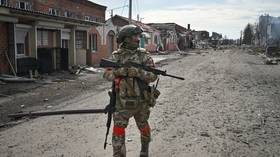Baltimore a sign of crisis in America

Leonard Gray used to leave his house in Baltimore every day to come to the Inner Harbor. It was a job, a living and a piece of Baltimore’s million-dollar revival. Until one day, Gray and the other 160 employees of Disney’s ESPN Zone were laid off.
"I worked here at ESPN Zone for six years and without notice they gave us the ax, they threw us out like we was just some paper cups," Gray said. That’s how Leonard joined the ranks of Baltimore’s unemployed – it’s a crowded place with 11.4 percent of the city’s residents. "Right now, I'm struggling to survive, struggling to pay my bills, sometimes I can't go to the market to eat," Gray said. But business is booming in the Inner Harbor, a luxury retail and dining district that the city has sunk millions into and made its model of economic development. "People think that the Inner Harbor is a happy-go-lucky place, but they don't know what's going on behind the scenes. People are being disrespected, people are getting unfair wages," said Gray. Like much of America--where the richest 20 percent own 84 percent of the wealth--Baltimore’s harbor is split along class lines, said Luis Larrin, a labor organizer with the grassroots United Workers organization. "The workers who work in these restaurants can’t even eat what they’re cooking because they’re charged the same price," Larrin said. "$7.00 for a hamburger, an hour’s wage. They could never even think of bringing their families to spend the day here." It's also split along racial lines, said sociologist and Professor Kris Marsh. "You can say it's a class thing, but ironically enough most of the people who are pushed out by this new development happen to be blacks, or happen to be Latinos," said Marsh. Just a few blocks East or West of the Harbor, the reality is much different--a city crumbling under the weight of foreclosures and crushing economic crisis. It was against this backdrop that President Obama announced 1.1 trillion dollars in cuts to the budget last month. On the domestic spending chopping block were 13.9 billion dollars in cuts to food stamp programs, which about 530,000 Maryland depend on. Maryland has seen a 32 percent increase since in food stamp recipients since 2008. Currently, 20 percent of Baltimore residents live below the poverty line--six percent more than when Obama stopped here days before his inauguration in 2009. "This is what I believe, Baltimore, but you made this belief real. You proved once more the people who love this country can change it," US President Barack Obama told a massive crowd gathered in 2009, days before his inauguration. But residents in these blocks and blocks of abandoned row-houses told us that they haven’t been able to change the spreading poverty threatening to engulf more and more of Baltimore.Ylan Mui, a staff writer for the Washington Post explained the system of capitalism creates a byproduct of inequality; it’s how the system is structured.“The question becomes, what are the social implications of that?” she said. “What are the economic implications of that? Does such a large amount of wealth being concentrated among the top tiers of American households, does that simulate economic growth, does that trickle down to other economic classes? What we are really grappling with is not necessarily the fact of income inequality, but the magnitude of income inequality.”Across the world and in the US food prices have been rising, further impacting lower income earners, a growing group in the US.“Lower income households spend a large portion of their income on food, on these basic necessities. That leaves them less money to spend on discretionary items, which is one thing that actually helps drive the economy,” Mui said. She explained it is important to think about the impact of food on consumers when measuring economic growth and costs. Necessity items are where most is spent for low income earners, and these items do not contribute to economic growth in the same was as other products. “Income inequality needs to be rectified,” she added. “There is a growing recognition that it is a problem.”















